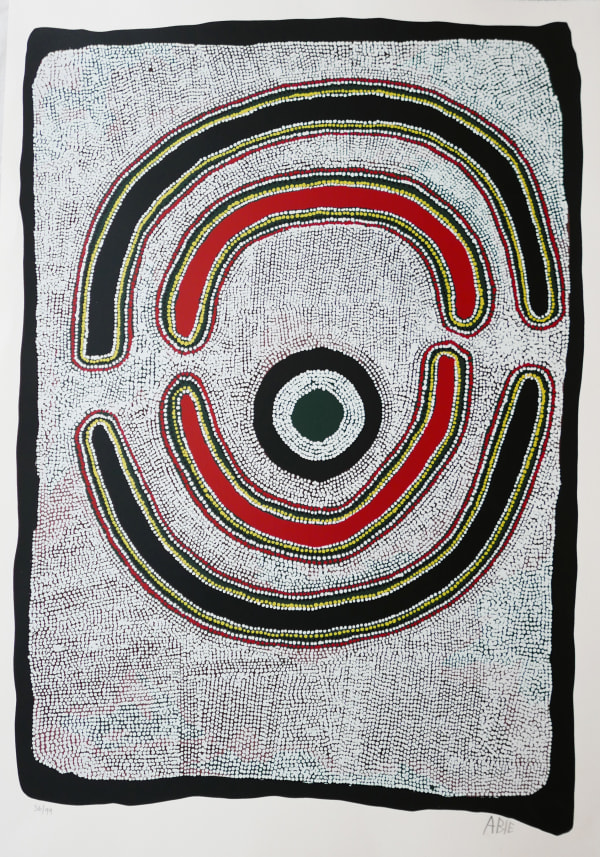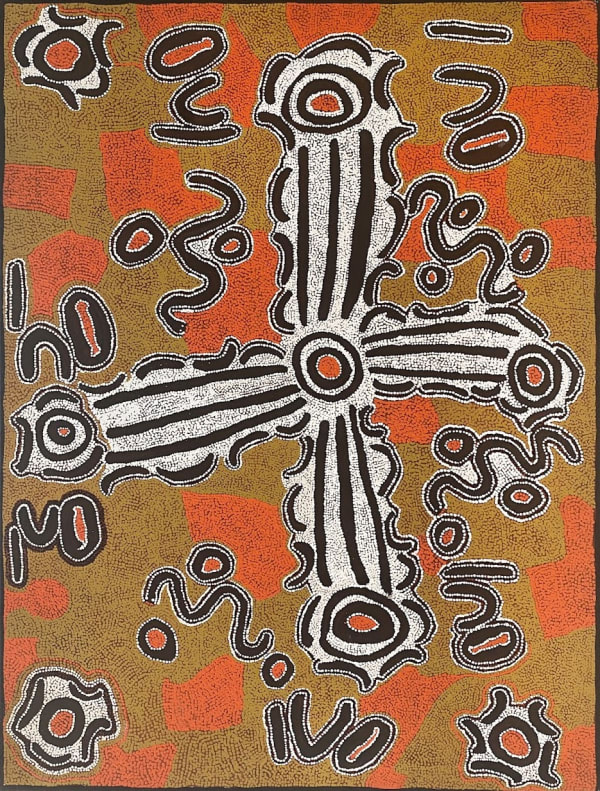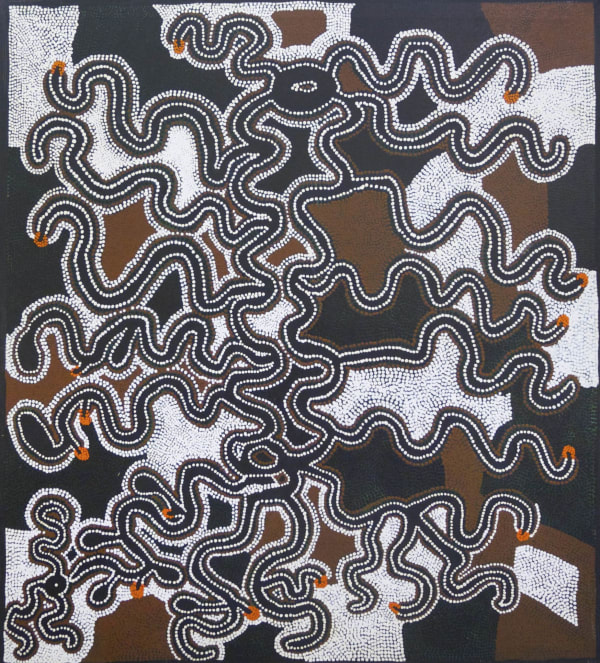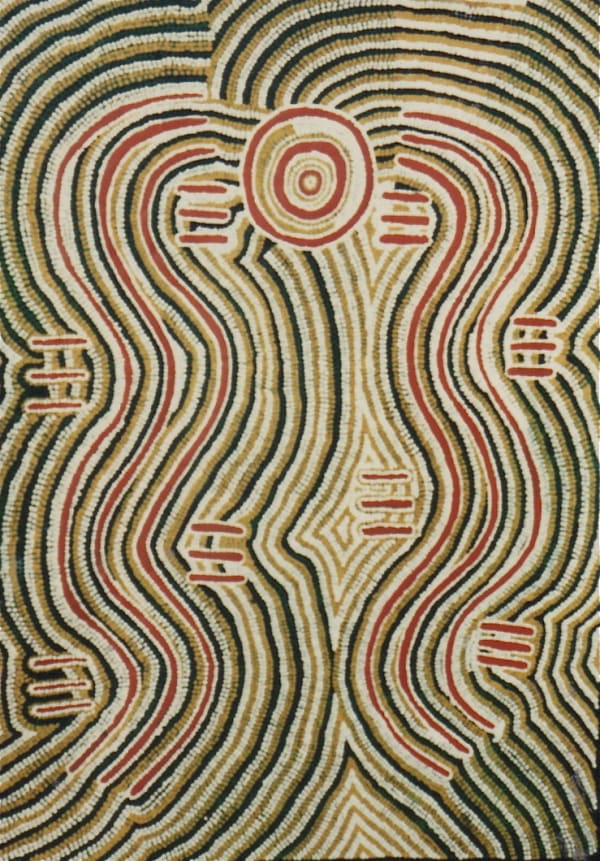The Lajamanu Aboriginal Community is situated on the edge of the Tanami Desert, midway between Alice Springs and Darwin, in the traditional country of the Gurindji people.
The paintings on show at the Rebecca Hossack Art Gallery from 6 - 31 August are unlike any other Aboriginal paintings ever created. They have an unselfconscious fluency of line and are essays in pure color. Pigment is applied loosely, tight symmetry is absent and space has a positive value. In ‘Ngalyipi’ by Ronnie Lawson Jakamarra, the myriad white dotting echoes the fluent rhythm of the rolling black lines or Jukupurra, (Dreaming tracks).
To an eye accustomed to the European Art of the 20th Century, these works bear a closer resemblance to Miro or Klee than to what is commonly thought of as ‘tribal art’.
The twenty paintings in this exhibition are created by men and women from Lajamanu. It is important to realize that Walpiri womens’ designs differ in mythological content and visual thrust from those of the men. In ‘Yawalyu’ (women’s rituals), principles of fertility and growth, and activities at a specific locality are stressed, whereas in men’s ceremonies, the routes taken by ancestors linking significant places are of primary importance. Women’s Kurawarri ancestral designs tend to be curvilinear, circular and formed of smaller, separate units in abundant clusters, whereas straight or meandering track lines dominate men’s designs, as in Jimmy Robertson’s ‘Ngapa Dreaming’.
All paintings created at Lajamanu are organic in rhythm. They have a striking beauty and formal intensity. No other Aboriginal community produces work with such a powerful use of Kurawarri ancestral signs and magical use of color in unexpected combinations. This is all the more extraordinary when one realizes that painting on canvas and board only began at Lajamanu five years ago in 1986. It began with a chaotic enthusiasm, as with bold vigor these artists confirmed their charters to particular tracts of land and re-enacted the paths that warna (snake), mala (wallaby), or Ngapa (water) ancestors followed through their country.
The painting preserves the knowledge of the Dreaming. It is done by those who still have the ‘healing stones’ inside their bodies. For many Aboriginals, white civilization has brought a sense of disempowerment and loss. Ronnie Lawson Jakamarra says 'now you will not find many people with those strong ngangkaya (healing) stones inside their bodies anymore. We have become weak from sweet food and drinking cordial'.
It is hoped that the painting will provide a bridge between white and Aboriginal culture. As Maurice Jupurrula Luther says,
'I not only learned the white man’s ways, but I also learned my corroborees. I got to know that part of my life, my religion, my dances and my songs…where my country was and where my Dreaming starts and ends.'
-
 Ronnie Lawson Tjakamarra, Bush Bean Dreaming II
Ronnie Lawson Tjakamarra, Bush Bean Dreaming II -
 Ronnie Lawson Tjakamarra, Wintirke – Bird , 1991
Ronnie Lawson Tjakamarra, Wintirke – Bird , 1991 -
 Ronnie Lawson Tjakamarra, Ngapa-Dreaming, 1991
Ronnie Lawson Tjakamarra, Ngapa-Dreaming, 1991 -
 Ronnie Lawson Tjakamarra, Bush Bean Dreaming
Ronnie Lawson Tjakamarra, Bush Bean Dreaming -
 Ronnie Lawson Tjakamarra, Men's Dreaming
Ronnie Lawson Tjakamarra, Men's Dreaming -
 Louisa Napaljarri Lawson, Women
Louisa Napaljarri Lawson, Women -
 Louisa Napaljarri Lawson, Kunajarraye Jukurrpa - Witchetty Grub Dreaming, 1989
Louisa Napaljarri Lawson, Kunajarraye Jukurrpa - Witchetty Grub Dreaming, 1989 -
 Abie Jangala, Women's Water Dreaming, 2000
Abie Jangala, Women's Water Dreaming, 2000 -
 Abie Jangala, Water Dreaming - Ngapa V, 1991
Abie Jangala, Water Dreaming - Ngapa V, 1991 -
 Abie Jangala, Water (Ngapa) Dreaming, n.d.
Abie Jangala, Water (Ngapa) Dreaming, n.d. -
 Abie Jangala, Water Dreaming - Ngapa III, 2000
Abie Jangala, Water Dreaming - Ngapa III, 2000 -
 Liddy Nelson Nakamarra, Yala - Bush Yam Dreaming, 1991
Liddy Nelson Nakamarra, Yala - Bush Yam Dreaming, 1991 -
 Beryl Nakamarra Barnes, Snake (Warna) Dreaming , 1991
Beryl Nakamarra Barnes, Snake (Warna) Dreaming , 1991 -
 Nancy Nangala Watson , Emu/Water (Ngapa) Dreaming , 1991
Nancy Nangala Watson , Emu/Water (Ngapa) Dreaming , 1991 -
 Nancy Nangala Watson , Water (Ngapa)/Turkey Dreaming, 1991
Nancy Nangala Watson , Water (Ngapa)/Turkey Dreaming, 1991 -
 Lorna Napurrula Fencer, Bush Potato (Yarla) Dreaming, 1991
Lorna Napurrula Fencer, Bush Potato (Yarla) Dreaming, 1991 -
 Lorna Napurrula Fencer, Seed (Ngurlu) Dreaming , 1991
Lorna Napurrula Fencer, Seed (Ngurlu) Dreaming , 1991 -
 Lorna Napurrula Fencer, Yams (Yarla) Dreaming , 1991
Lorna Napurrula Fencer, Yams (Yarla) Dreaming , 1991 -
 Lorna Napurrula Fencer, Yams (Yarla) Dreaming, 1991
Lorna Napurrula Fencer, Yams (Yarla) Dreaming, 1991 -
 Judy Napangardi Granites, Honey Ants (Yurrumpi) Dreaming, 1991
Judy Napangardi Granites, Honey Ants (Yurrumpi) Dreaming, 1991 -
 Judy Napangardi Jigili, Women (Karnta) Dreaming, 1991
Judy Napangardi Jigili, Women (Karnta) Dreaming, 1991 -
 Judy Napangardi Jigili, Women (Karnta) Dreaming, 1991
Judy Napangardi Jigili, Women (Karnta) Dreaming, 1991 -
 Biddy Napaljarri Rockman, Snake (Warna) Dreaming , 1991
Biddy Napaljarri Rockman, Snake (Warna) Dreaming , 1991 -
 Biddy Nungurrayi Long, Water (Ngapa) Dreaming, 1991
Biddy Nungurrayi Long, Water (Ngapa) Dreaming, 1991 -
 Biddy Nungurrayi Long, Bushvine Ngalyipi - Snake, 1994
Biddy Nungurrayi Long, Bushvine Ngalyipi - Snake, 1994 -
 Peggy Napaljarri Rockman, Sick Husband and Wives, 1994
Peggy Napaljarri Rockman, Sick Husband and Wives, 1994 -
 Rosie Tasman Napurrula, Seed (Ngurlu) Dreaming, 1991
Rosie Tasman Napurrula, Seed (Ngurlu) Dreaming, 1991 -
 Rosie Tasman Napurrula, Seed (Ngurlu) Dreaming, 1991
Rosie Tasman Napurrula, Seed (Ngurlu) Dreaming, 1991 -
 Lucy Nangala Hector, Seed (Ngarlu) Dreaming , 1991
Lucy Nangala Hector, Seed (Ngarlu) Dreaming , 1991 -
 Maisie Napangardi Granites, Women (Karnta) Dreaming, 1991
Maisie Napangardi Granites, Women (Karnta) Dreaming, 1991 -
 Topsy Nangala Ross, Water (Ngapa) Dreaming, 1991
Topsy Nangala Ross, Water (Ngapa) Dreaming, 1991 -
 Lily Hargraves, Women Ceremony, 1991
Lily Hargraves, Women Ceremony, 1991 -
 Lily Hargraves, Bushvine (Ngalyipi) Dreaming, 1991
Lily Hargraves, Bushvine (Ngalyipi) Dreaming, 1991 -
 Judy Napaljarri Walker, Fire/Women Dreaming, 1991
Judy Napaljarri Walker, Fire/Women Dreaming, 1991 -
 Molly Tasman Napurrurla, Bush Plums Dreaming, 1991
Molly Tasman Napurrurla, Bush Plums Dreaming, 1991 -
 Jean Napurrula Birrel, Budgerrigarr Dreaming, 1991
Jean Napurrula Birrel, Budgerrigarr Dreaming, 1991




































